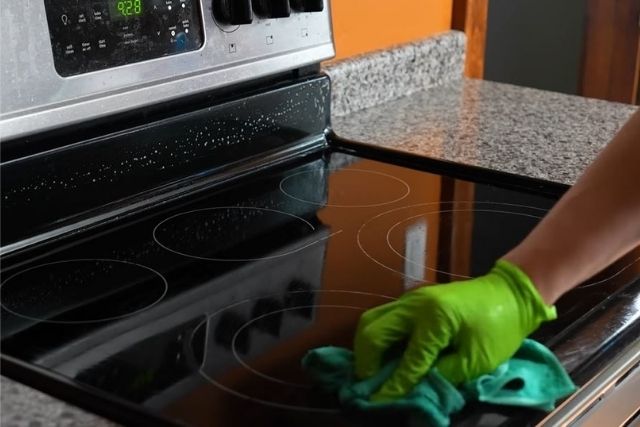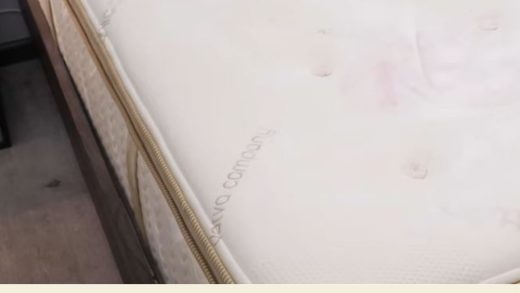Your stovetop is a workhorse in the kitchen, helping you accomplish everything from sautéing vegetables to pan-searing chicken. Because of how often it’s used, stovetops easily build up with oil splatter, burnt-on food pieces, and other debris. If you don’t clean the surface frequently, this accumulated grime can negatively impact your stovetop’s efficacy and even become a safety hazard. Luckily, if you have a glass stovetop, this buildup is much easier to maintain and can be cleaned with a few basic materials. Ahead, our experts explain how to clean a glass stovetop so it’s both clean and functional for everyday use.

Materials Needed
Make sure you have these materials on hand before getting started. Note that the materials you need may vary depending on your chosen cleaning method.
- Non-abrasive cleaning pad
- Microfiber cloth(s)
- Distilled white vinegar
- Water
- Dish soap
- Commercial cleaner designed for glass stovetops
How to Clean Your Glass Stovetop With a DIY Cleaner
Cleaning a glass stovetop with a DIY cleaner is as simple as combining a few common household ingredients and applying them to the surface. We have two methods for you to try, depending on the severity of your stovetop’s buildup.
Method 1: White Vinegar and Water
- Wipe the stovetop surface with a non-abrasive cleaning pad to remove any loose debris.
- Combine equal parts white vinegar and water in a spray bottle.
- Carefully cleanse the surface using a non-abrasive cleaning pad.
- Remove the cleaning solution with a damp microfiber cloth.
- Wipe dry with a microfiber cloth.
- If needed, repeat the process to remove remaining residue or stains.
Method 2: White Vinegar and Dish Soap
- Wipe the stovetop surface with a non-abrasive cleaning pad to remove any loose debris.
- Combine equal parts white vinegar and water in a spray bottle, adding a bit of dish soap for tougher stains.
- Apply the mixture to the surface and let it sit for a few minutes to break down any residue.
- Carefully cleanse the surface using a non-abrasive cleaning pad.
- Remove the cleaning solution with a damp cloth.
- Wipe dry with a microfiber cloth.
How to Clean Your Glass Stovetop With a Commercial Cleaner
To clean a glass stovetop using a commercial cleaner, make sure the spray is specifically designed to clean glass cooktops, says Jeramy Sibley, president of Glass Doctor, a Neighborly company.
- Wipe the stovetop surface with a non-abrasive cleaning pad to remove any loose debris.
- Apply a few drops of liquid cleaner to the surface.
- Carefully cleanse the surface using a non-abrasive cleaning pad.
- Remove the cleaning solution with a damp cloth.
- Wipe dry with a microfiber cloth.
How to Prevent Scratches on Your Glass Stovetop
Despite being easier to clean than some other types of stovetops, glass can be scratched easily if not cared for properly. Keep these factors in mind to prevent causing any unintended damage to your cooktop.
- Avoid using abrasive materials like steel wool or harsh scrub brushes, as they can scratch or damage the glass surface. “Instead, use microfiber cloths or non-abrasive sponges,” says Alicia Sokolowski, the president and co-CEO of Aspen Clean.
- Use cleaners specifically designed for glass stovetops. “Avoid using harsh chemicals that can damage the glass or release toxic fumes when heated,” says Sokolowski.
- Try not to drag rough pots and pans across your glass stovetop, as this can cause micro-scratches. “Over time, these scratches can accumulate and potentially weaken the glass, leading to cracks,” says Sibley.
- Avoid dropping anything heavy on your glass stovetop. “While glass-ceramic stovetops are durable, they are still vulnerable to damage from heavy objects,” says Sibley.
Importance of Cleaning Your Glass Stovetop
Cleaning your glass stovetop regularly is essential for maintaining its appearance and functionality over time. “Food residues that are left to burn on the stovetop can lead to the development of hot spots, which may result in cracks on the glass surface,” says Sibley.
Glass cracking isn’t the only safety concern improper maintenance poses. “Grease, food particles, and spills on a glass stovetop can become potential fire hazards,” says Sokolowski. “If these substances are left to accumulate and heat up, they might ignite and cause a fire.”
How Often to Clean Your Glass Stovetop
You should wipe down your glass stovetop after every use, which prevents the buildup of food residue, grease, and spills. “In addition to after-use wiping, it’s recommended to perform a deeper cleaning at least once a week,” says Sokolowski. Additionally, you should clean up spills and stains as soon as the stovetop has cooled down.
Stovetop Cleaning Safety Precautions
When cleaning your stovetop, there are a few precautions you should take to keep yourself safe.
- Ensure the stovetop is turned off and completely cooled down prior to cleaning. “Hot surfaces can cause burns if you accidentally touch them during cleaning,” says Sokolowski.
- Open windows or use exhaust fans in your kitchen when cleaning to improve ventilation.
- Minimize the amount of water or cleaning solution that comes into contact with the electrical components of the stove, says Sokolowski. Water or moisture can lead to electrical problems or damage.
How to Remove Stuck-On Residue
Sometimes regular cleaning isn’t enough. Stubborn burnt-on food and residue can be difficult to remove and may require extra care. When that happens, try this simple method:
- Sprinkle baking soda over the area.
- Soak a clean towel in hot water. Wring it out so that it’s not dripping wet.
- Lay the towel over the baking soda, and let it sit for 10 minutes.
- Gently wipe away residue with the towel.
- Finish with a spritz of your favorite glass stovetop-safe cleaner. Wipe with a microfiber cloth.


